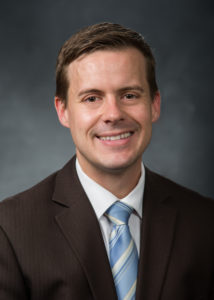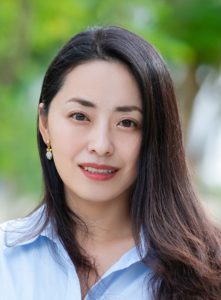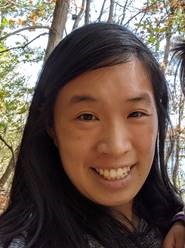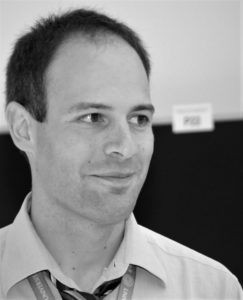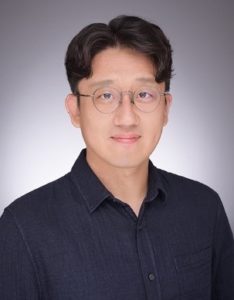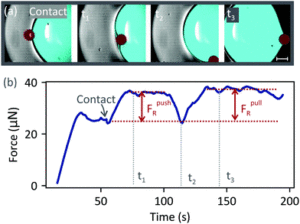It is with great pleasure that we announce Prof Silvia Marchesan (University of Trieste) as the recipient of the 2021 Soft Matter lectureship.
This award, now in its thirteenth year, honours an early-career researcher who has made significant contribution to the soft matter field. The recipient is selected by the Soft Matter Editorial Board from a list of candidates nominated by the community.
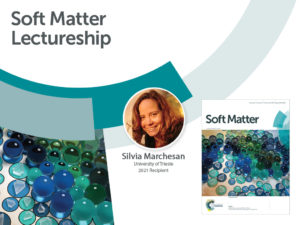
Silvia completed her PhD in Chemistry at The University of Edinburgh in 2008 and did her postdoc research at the University of Helsinki (Finland), then at Monash University in a joint position with Australia’s national science agency (CSIRO). In 2013 she returned to Italy and secured a tenure-track academic position in 2015 at the University of Trieste, where she started to work on nanostructured materials as PI thanks to a starting grant by the Italian Ministry of Education and Research. In 2018 she became associate professor and obtained the national Habilitation as full professor in organic chemistry. She was featured amongst the 11 Rising Stars profiles in the natural sciences by Nature Index in 2018 for her multidisciplinary research that spans across chemistry, biophysics, nanotechnology and materials science.
Silvia leads the SuperStructures group and can be found on Twitter @MarchesanLab. She is interested in the control over the self-organization of molecules into superstructures that span over a sizescale that goes well beyond that of the single components. Her group’s main activities focus on the use of both D- and L- amino acids to form short heterochiral peptides that self-organize into different architectures. Their favourite systems are in water and they can be in the form of biomaterials (hydrogels), or nanostructures, for biological applications and they also also enjoy working on carbon nanomaterials (CNT, graphene, nanohorns, etc.) that they covalently functionalize to exert control over their properties, in this case both for energy or biological applications.
Read Silvia’s latest article in Soft Matter “Supramolecular hydrogels from unprotected dipeptides: a comparative study on stereoisomers and structural isomers” which was in our peptide soft materials collection for FREE until 1 August. Also check out articles from our previous lectureship winners in our lectureship lectureship winners collection.
How has your research evolved from your first article to this most recent article?
In my first article as corresponding author, it was all about data interpretation, yet many questions were left unaswered. Over the years, the transition has been towards understanding the exact reasons behind unexpected observations, and identifying design rules for self-assembling minimalistic systems that gel and exert various functions (e.g. catalysis, drug delivery, amyloid fibril inhibition, etc.). On the journey, I have encountered great scientists, some of which have become collaborators from different disciplines that complement our skills and with whom we engage in stimulating discussions and learn something new every day!
What excites you most about your area of research and what has been the most exciting moment of your career so far?
What I love about our research on soft matter is that, especially in the case of supramolecular hydrogels, we can monitor the “dance” of molecules as they interact across size scales, using diverse techniques at the molecular, nano-, micro-, up to the macroscale, and we can actually see by eye the net outcome of the assembly process. It is stupefying to visually observe changes in a vial and understand the process that brings molecules together into a nanostructured, yet macroscopic, material.
The most exciting moment came after a long series of grant rejections, as I started to think of plan B, outside of academia, and wrapped up the scientific passion project that was keeping me awake at night, in what I thought was going to be the last proposal. I couldn’t believe my eyes when I discovered that it got funded with a starting package from the Italian Ministry of Research (MIUR). That was a game-changer and I remember standing in awe in front of the lab door with the name “Superstructures Lab”, thinking that finally I could realise the science that, until then, I could only dream of.
In your opinion, what are the most important questions to be asked/answered in your field of research?
I think there’s still a knowledge gap at the mesoscale. We understand well how to design and control molecules and nanostructures on one hand, and macroscopic materials on the other. However, sometimes a link goes missing in the middle, and geometrical errors accumulate in the process of structure amplification until it stops at the microscale, or it fails before then. I think that understanding and controlling how this happens, and how multiple components can exert orthogonal functions in complex systems, will open the way to a qualitative leap in the field. We are working very hard to uncover general design rules to go all the way from simple molecules to supramolecular materials, and peptides’ diversity renders the task an exciting challenge.
How do you feel about Soft Matter as a place to publish research on this topic?
Our work is at the interface of chemistry, biophysics, nanotechnology, and materials science. Most journals focus on one discipline or another, while Soft Matter readers are the perfect audience for mutlidisciplinary research of this type. The RSC publishing platform is very simple to use, and we experienced short peer-review times and constructive feedback that ultimately allowed us to grow as scientists and it enhanced the quality of our work.
In which upcoming conferences or events (online or in person) may our readers meet you?
In 2021, I’ll be at the “Design and Function of Stimuli Responsive Nanocomposites” Symposium at UCD, at the ACS Fall Meeting, the EMBO Workshop on Designing Functional Biomolecular Assemblies, and I’ll close the year in Caparica (Portugal) with the Conference on Translational Chemistry (IC3TC).
Can you share one piece of career-related advice or wisdom with early career scientists?
Find an inspiring environment and mentor to help you find your path, do the science that makes you dream of it, engage with the community at large, professional and local (schools, public). The more you practise discussing science the clearer and better your ideas become.
How do you spend your spare time?
I wish I had spare time! I love rock concerts, art exhibitions, and going for hikes in dramatic landscapes. I am very fortunate that Italy on this front has lots to offer, and Trieste in particular, as it is a gem nested between the Alps and the Mediterranean, with the bonus of a synchrotron in between! Scientists are always welcome to visit us!
We would like to thank everybody who nominated a candidate for the 2021 Soft Matter Lectureship. The Editorial Board had a very difficult task in choosing a winner from the many excellent and worthy candidates.
Please join us in congratulating Silvia on winning this award!
Comments Off on 2021 Soft Matter Lectureship awarded to Silvia Marchesan


